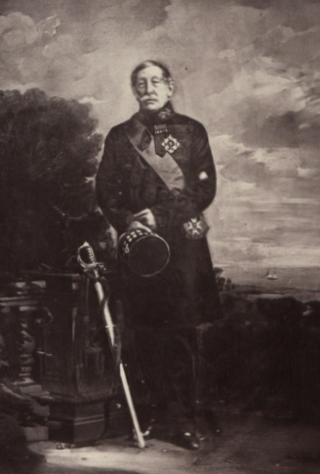Related Research Articles

Field Marshal Sir Hew Dalrymple Ross, was a British Army officer. After seeing active service during the Irish Rebellion of 1798, he fought as a troop commander in many of the battles of the Peninsular War and the Hundred Days. He went on to become the Artillery Commander, Northern District with delegated command over all the forces of the four northern counties before being promoted to Deputy Adjutant-General, Royal Artillery. Ross was the last person to hold the title of Lieutenant-General of the Ordnance, assuming responsibility for the artillery component sent to take part in the Crimean War under Lord Raglan. After the war he served as Master Gunner, St James's Park, a senior ceremonial post in the Royal Artillery.

Major General Sir Alexander Dickson was a British Army officer who served in the artillery. He fought at many battles during the Napoleonic Wars. Arthur Wellesley, 1st Duke of Wellington had the highest opinion of his abilities and made him the effective commander of his army's artillery during the latter part of the Peninsular War.

Field Marshal Sir William Maynard Gomm was a British Army officer. After taking part in the Anglo-Russian invasion of Holland, he served in most of the battles of the Napoleonic Wars. During the Hundred Days he took part in both the Battle of Quatre Bras and the Battle of Waterloo. He went on to be Commander of the troops in Jamaica and in that role established new barracks at Newcastle, Jamaica, high in the mountains. After that he became Governor of Mauritius and, finally, Commander-in-Chief, India, in which role he introduced promotion examinations for officers.

The 50th Regiment of Foot was an infantry regiment of the British Army, raised in 1755. Under the Childers Reforms it amalgamated with the 97th Regiment of Foot to form the Queen's Own Royal West Kent Regiment in 1881.

Field Marshal Sir Alexander George Woodford, GCB, KCMG, was a British Army officer. After taking part in the Anglo-Russian invasion of Holland, he served in most of the battles of the Napoleonic Wars. During the Hundred Days he commanded the 2nd battalion of the Coldstream Guards at the Battle of Quatre Bras, the Battle of Waterloo and the storming of Cambrai. He went on to become lieutenant governor and brigade commander at Malta, lieutenant governor and brigade commander at Corfu and then commander of the British garrison on the Ionian Islands before being appointed Governor and Commander-in-Chief of Gibraltar.
Lieutenant General Sir William Nicolay was a British Army officer present at the Battle of Waterloo who later became Governor of Mauritius. He was the sixth son - not the third -
Lieutenant General Sir John Angus Macleod GCH was Master Gunner, St James's Park, the most senior ceremonial post in the Royal Artillery after the sovereign.
Lieutenant-General Sir William Brereton was a British Army officer of the nineteenth century who served as colonel-commandant of the 4th Brigade, Royal Horse Artillery in the 1860s.
General Sir Anthony Farrington, 1st Baronet DCL was a British Army officer of the Royal Artillery. He served in Gibraltar and in the American War of Independence.
Lieutenant-Colonel Joseph Brome was a British Royal Artillery officer who served during the Napoleonic Wars.
Colonel John Suther Williamson was a British Army officer who served in the Royal Artillery during the Napoleonic Wars.

Lieutenant-General Robert Lawson was a British Army officer who served in the Royal Artillery during the American War of Independence and the Egyptian Campaign.
Charles Best was a British army officer of Hanoverian descent who served in the armies of the East India Company, Britain and Hanover from 1781 until the end of the Napoleonic Wars.
Colonel Sir William Robe was a British Army officer of the Royal Artillery who served in the Revolutionary and Napoleonic Wars. He was praised as an artillery commander in combat and an organiser of military operations, as well as starting the first regimental school for soldiers' children, and serving as the architect of Quebec's Anglican cathedral.
Lieutenant-General Sir Wiltshire Wilson was a general officer of the British Army who served in the Royal Artillery for some forty-five years, including several campaigns of the Revolutionary and Napoleonic Wars.

Stephen Galway Adye CB was a British Army officer who fought at the Battle of Waterloo.
Alexander Hamilton CB was a British Army officer of the Napoleonic Wars who was injured at the Battle of Quatre Bras on 16 June 1815 but recovered sufficiently to command a battalion at the Battle of Waterloo two days later.

Major-General Sir George Adam Wood CB K.St.V KCH KMT was a British Army officer who served in the Peninsular War and fought at the Battle of Waterloo on 18 June 1815.
The 1919 New Year Honours were appointments by King George V to various orders and honours to reward and highlight good works by citizens of the British Empire. The appointments were published in The London Gazette and The Times in January 1919.
General Charles Terrot (1758–1839) was an English army officer in the Royal Artillery.
References
- Glover, Gareth (2010), Waterloo Archive Vol 1: British Sources, vol. 1 (illustrated ed.), Frontline Books, p. 246, ISBN 9781848325401
- Urban, Sylvanus, ed. (January–June 1843), "Obituary: Major-Gen. Percy Drummond C.B.", Gentleman's Magazine , 173: 320